Moscow ( MOS-koh, US chiefly MOS-kow; Russian: Москва, tr. Moskva, IPA: [mɐskˈva] ) is the capital and largest city of Russia. The city stands on the Moskva River in Central Russia, with a population estimated at 13.0 million residents within the city limits, over 18.8 million residents in the urban area, and over 21.5 million residents in the metropolitan area. The city covers an area of 2,511 square kilometers (970 sq mi), while the urban area covers 5,891 square kilometers (2,275 sq mi), and the m...Read more
Moscow ( MOS-koh, US chiefly MOS-kow; Russian: Москва, tr. Moskva, IPA: [mɐskˈva] ) is the capital and largest city of Russia. The city stands on the Moskva River in Central Russia, with a population estimated at 13.0 million residents within the city limits, over 18.8 million residents in the urban area, and over 21.5 million residents in the metropolitan area. The city covers an area of 2,511 square kilometers (970 sq mi), while the urban area covers 5,891 square kilometers (2,275 sq mi), and the metropolitan area covers over 26,000 square kilometers (10,000 sq mi). Moscow is among the world's largest cities, being the most populous city entirely in Europe, the largest urban and metropolitan area in Europe, and the largest city by land area on the European continent.
First documented in 1147, Moscow grew to become a prosperous and powerful city that served as the capital of the Grand Duchy of Moscow. When the Tsardom of Russia was proclaimed, Moscow remained the political and economic center for most of its history. Under the reign of Peter the Great, the Russian capital was moved to the newly founded city of Saint Petersburg in 1712, diminishing Moscow's influence. Following the Russian Revolution and the establishment of the Russian SFSR, the capital was moved back to Moscow in 1918, where it later became the political center of the Soviet Union. In the aftermath of the dissolution of the Soviet Union, Moscow remained the capital city of the newly established Russian Federation.
The northernmost and coldest megacity in the world, Moscow is governed as a federal city, where it serves as the political, economic, cultural, and scientific center of Russia and Eastern Europe. As an alpha world city, Moscow has one of the world's largest urban economies. The city is one of the fastest-growing tourist destinations in the world, and is one of Europe's most visited cities. Moscow is home to the sixth-highest number of billionaires of any city in the world. The Moscow International Business Center is one of the largest financial centers in Europe and the world, and features the majority of Europe's tallest skyscrapers. Moscow was the host city of the 1980 Summer Olympics, and one of the host cities of the 2018 FIFA World Cup.
As the historic core of Russia, Moscow serves as the home of numerous Russian artists, scientists, and sports figures due to the presence of its various museums, academic and political institutions, and theaters. The city is home to several UNESCO World Heritage Sites and is well known for its display of Russian architecture, particularly its historic Red Square, and buildings such as the Saint Basil's Cathedral and the Moscow Kremlin, of which the latter serves as the seat of power of the Government of Russia. Moscow is home to many Russian companies in numerous industries and is served by a comprehensive transit network, which includes four international airports, ten railway terminals, a tram system, a monorail system, and most notably the Moscow Metro, the busiest metro system in Europe, and one of the largest rapid transit systems in the world. The city has over 40 percent of its territory covered by greenery, making it one of the greenest cities in the world.
Archaeological digs show that the site of today's Moscow and the surrounding area have been inhabited since time immemorial. Among the earliest finds are relics of the Lyalovo culture, which experts assign to the Neolithic period, the last phase of the Stone Age.[1]
They confirm that the first inhabitants of the area were hunters and gatherers. Around 950 AD, two Slavic tribes, Vyatichi and Krivichi, settled here. Possibly the Vyatichi formed the core of Moscow's indigenous population.[2]
Early history (1147–1284) Vladimir-Suzdal, a principality on the northeastern periphery of Kievan Rus', grew into the Grand Duchy of Moscow.
Vladimir-Suzdal, a principality on the northeastern periphery of Kievan Rus', grew into the Grand Duchy of Moscow.The first known reference to Moscow dates from 1147 as a meeting place of Yuri Dolgoruky and Sviatoslav Olgovich. At the time it was a minor town on the western border of Vladimir-Suzdal Principality. The chronicle says, "Come, my brother, to Moskov" (Приди ко мне, брате, в Москов).[3]
In 1156, Knyaz Yuri Dolgorukiy fortified the town with a timber fence and a moat. In the course of the Mongol invasion of Kievan Rus', the Mongols under Batu Khan burned the city to the ground and killed its inhabitants.[citation needed]
The timber fort na Moskvě "on the Moscow River" was inherited by Daniel, the youngest son of Alexander Nevsky, in the 1260s, at the time considered the least valuable of his father's possessions. Daniel was still a child at the time, and the big fort was governed by tiuns (deputies), appointed by Daniel's paternal uncle, Yaroslav of Tver.[citation needed]
Daniel came of age in the 1270s and became involved in the power struggles of the principality with lasting success, siding with his brother Dmitry in his bid for the rule of Novgorod. From 1283 he acted as the ruler of an independent principality alongside Dmitry, who became Grand Duke of Vladimir. Daniel has been credited with founding the first Moscow monasteries, dedicated to the Lord's Epiphany and to Saint Daniel.[4]
Grand Duchy (1283–1547)
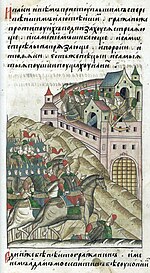
 The Moscow Kremlin in the late 16th century
The 1382 siege of Moscow
Red Square
The Moscow Kremlin in the late 16th century
The 1382 siege of Moscow
Red Square
Daniel ruled Moscow as Grand Duke until 1303 and established it as a prosperous city that would eclipse its parent principality of Vladimir by the 1320s.
On the right bank of the Moskva River, at a distance of eight kilometres (5 mi) from the Kremlin, not later than in 1282, Daniel founded the first monastery with the wooden church of St. Daniel-Stylite, which is now the Danilov Monastery. Daniel died in 1303, at the age of 42. Before his death, he became a monk and, according to his will, was buried in the cemetery of the St. Daniel Monastery.
Moscow was quite stable and prosperous for many years and attracted a large number of refugees from across Russia. The Rurikids maintained large landholdings by practicing primogeniture, whereby all land was passed to the eldest sons, rather than dividing it up among all sons. By 1304, Yury of Moscow contested with Mikhail of Tver for the throne of the principality of Vladimir. Ivan I eventually defeated Tver to become the sole collector of taxes for the Mongol rulers, making Moscow the capital of Vladimir-Suzdal. By paying high tribute, Ivan won an important concession from the Khan.
 Spassky Cathedral (Moscow's oldest extant building), built c. 1357
Spassky Cathedral (Moscow's oldest extant building), built c. 1357While the Khan of the Golden Horde initially attempted to limit Moscow's influence, when the growth of the Grand Duchy of Lithuania began to threaten all of Russia, the Khan strengthened Moscow to counterbalance Lithuania, allowing it to become one of the most powerful cities in Russia. In 1380, prince Dmitry Donskoy of Moscow led a united Russian army to an important victory over the Mongols in the Battle of Kulikovo. Afterward, Moscow took the leading role in liberating Russia from Mongol domination. In 1480, Ivan III had finally broken the Russians free from Tatar control, and Moscow became the capital of an empire that would eventually encompass all of Russia and Siberia, and parts of many other lands.
 The Spasskaya Tower, built in 1491
The Spasskaya Tower, built in 1491In 1462 Ivan III, (1440–1505) became Grand Prince of Moscow (then part of the medieval Muscovy state). He began fighting the Tatars, enlarged the territory of Muscovy, and enriched his capital city. By 1500 it had a population of 100,000 and was one of the largest cities in the world. He conquered the far larger principality of Novgorod to the north, which had been allied to the hostile Lithuanians. Thus he enlarged the territory sevenfold, from 430,000 to 2,800,000 square kilometres (170,000 to 1,080,000 square miles). He took control of the ancient "Novgorod Chronicle" and made it a propaganda vehicle for his regime.[5][6]
The original Moscow Kremlin was built in the 14th century. It was reconstructed by Ivan, who in the 1480s invited architects from Renaissance Italy, such as Petrus Antonius Solarius, who designed the new Kremlin wall and its towers, and Marco Ruffo who designed the new palace for the prince. The Kremlin walls as they now appear are those designed by Solarius, completed in 1495. The Kremlin's Great Bell Tower was built in 1505–08 and augmented to its present height in 1600.
A trading settlement, or posad, grew up to the east of the Kremlin, in the area known as Zaradye (Зарядье). In the time of Ivan III, the Red Square, originally named the Hollow Field (Полое поле) appeared.
In 1508–1516, the Italian architect Aleviz Fryazin (Novy) arranged for the construction of a moat in front of the eastern wall, which would connect the Moskva and Neglinnaya and be filled in with water from Neglinnaya. This moat, known as the Alevizov moat and having a length of 541 metres (1,775 feet), width of 36 metres (118 feet), and a depth of 9.5 to 13 metres (31–43 feet) was lined with limestone and, in 1533, fenced on both sides with low, four-metre-thick (13-foot) cogged-brick walls.
Tsardom (1547–1721)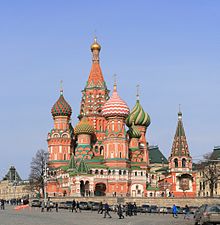 Saint Basil's Cathedral, built in 1561
Saint Basil's Cathedral, built in 1561In the 16th and 17th centuries, the three circular defenses were built: Kitay-gorod (Китай-город), the White City (Белый город) and the Earthen City (Земляной город). However, in 1547, two fires destroyed much of the town, and in 1571 the Crimean Tatars captured Moscow, burning everything except the Kremlin.[7] The annals record that only 30,000 of 200,000 inhabitants survived.
 View of 17th-century Moscow (1922 drawing by Apollinary Vasnetsov)
View of 17th-century Moscow (1922 drawing by Apollinary Vasnetsov)The Crimean Tatars attacked again in 1591, but this time were held back by new defense walls, built between 1584 and 1591 by a craftsman named Fyodor Kon. In 1592, an outer earth rampart with 50 towers was erected around the city, including an area on the right bank of the Moscow River. As an outermost line of defense, a chain of strongly fortified monasteries was established beyond the ramparts to the south and east, principally the Novodevichy Convent and Donskoy, Danilov, Simonov, Novospasskiy, and Andronikov monasteries, most of which now house museums. From its ramparts, the city became poetically known as Bielokamennaya, the "White-Walled." The city's limits as marked by the ramparts built in 1592 are now marked by the Garden Ring.
Three square gates existed on the eastern side of the Kremlin wall, which in the 17th century, were known as Konstantino-Eleninsky, Spassky, Nikolsky (owing their names to the icons of Constantine and Helen, the Saviour and St. Nicholas that hung over them). The last two were directly opposite the Red Square, while the Konstantino-Elenensky gate was located behind Saint Basil's Cathedral.
 "Sigismundian" Plan of Moscow (1610), named after Sigismund III of Poland, is the last city plan compiled before the destruction of the city in 1612 by retreating Polish troops and subsequent changes to the street network. Orientation: north is at the right, west at the top.
"Sigismundian" Plan of Moscow (1610), named after Sigismund III of Poland, is the last city plan compiled before the destruction of the city in 1612 by retreating Polish troops and subsequent changes to the street network. Orientation: north is at the right, west at the top.The Russian famine of 1601–03 killed perhaps 100,000 in Moscow. From 1610 through 1612, troops of the Polish–Lithuanian Commonwealth occupied Moscow, as its ruler Sigismund III tried to take the Russian throne. In 1612, the people of Nizhny Novgorod and other Russian cities conducted by prince Dmitry Pozharsky and Kuzma Minin rose against the Polish occupants, besieged the Kremlin, and expelled them. In 1613, the Zemsky sobor elected Michael Romanov tsar, establishing the Romanov dynasty. The 17th century was rich in popular risings, such as the liberation of Moscow from the Polish–Lithuanian invaders (1612), the Salt Riot (1648), the Copper Riot (1662), and the Moscow Uprising of 1682.
During the first half of the 17th century, the population of Moscow doubled from roughly 100,000 to 200,000. It expanded beyond its ramparts in the later 17th century. It is estimated, that in the middle of the 17th century, 20% of Moscow suburb's inhabitants were from the Grand Duchy of Lithuania, practically all of them being driven from their homeland to Moscow by Muscovite invaders.[8] By 1682, there were 692 households established north of the ramparts, by Ukrainians and Belarusians abducted from their hometowns in the course of the Russo-Polish War (1654–1667). These new outskirts of the city came to be known as the Meshchanskaya sloboda, after Ruthenian meshchane "town people". The term meshchane (мещане) acquired pejorative connotations in 18th-century Russia and today means "petty bourgeois" or "narrow-minded philistine".[9]
The entire city of the late 17th century, including the slobodas that grew up outside the city ramparts, are contained within what is today Moscow's Central Administrative Okrug.
Numerous disasters befell the city. The plague epidemics ravaged Moscow in 1570–1571, 1592 and 1654–1656.[10] The plague killed upwards of 80% of the people in 1654–55. Fires burned out much of the wooden city in 1626 and 1648.[11] In 1712 Peter the Great moved his government to the newly built Saint Petersburg on the Baltic coast. Moscow ceased to be Russia's capital, except for a brief period from 1728 to 1732 under the influence of the Supreme Privy Council.
Empire (1721–1917) Moskva riverfront in the 19th century
Moskva riverfront in the 19th centuryAfter losing the status as the capital of the empire, the population of Moscow at first decreased, from 200,000 in the 17th century to 130,000 in 1750. But after 1750, the population grew more than tenfold over the remaining duration of the Russian Empire, reaching 1.8 million by 1915. The 1770–1772 Russian plague killed up to 100,000 people in Moscow.[12]
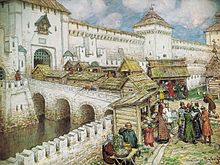 Bookshops at the Novospassky Bridge in the 17th century, by Apollinary Vasnetsov
Bookshops at the Novospassky Bridge in the 17th century, by Apollinary VasnetsovBy 1700, the building of cobbled roads had begun. In November 1730, the permanent street light was introduced, and by 1867 many streets had a gaslight. In 1883, near the Prechistinskiye Gates, arc lamps were installed. In 1741 Moscow was surrounded by a barricade 40 kilometres (25 mi) long, the Kamer-Kollezhskiy barrier, with 16 gates at which customs tolls were collected. Its line is traced today by a number of streets called val ("ramparts"). Between 1781 and 1804 the Mytischinskiy water pipe (the first in Russia) was built. In 1813, following the destruction of much of the city during the French occupation, a Commission for the Construction of the City of Moscow was established. It launched a great program of rebuilding, including a partial replanning of the city-centre. Among many buildings constructed or reconstructed at this time was the Grand Kremlin Palace and the Kremlin Armoury, the Moscow University, the Moscow Manege (Riding School), and the Bolshoi Theatre. In 1903 the Moskvoretskaya water supply was completed.
In the early 19th century, the Arch of Konstantino-Elenensky gate was paved with bricks, but the Spassky Gate was the main front gate of the Kremlin and used for royal entrances. From this gate, wooden and (following the 17th-century improvements) stone bridges stretched across the moat. Books were sold on this bridge and stone platforms were built nearby for guns – "raskats". The Tsar Cannon was located on the platform of the Lobnoye mesto.
The road connecting Moscow with St. Petersburg, now the M10 highway, was completed in 1746, its Moscow end following the old Tver road, which had existed since the 16th century. It became known as Peterburskoye Schosse after it was paved in the 1780s. Petrovsky Palace was built in 1776–1780 by Matvey Kazakov.
 Napoleon retreating from the city during the Fire of Moscow, after the failed French Invasion of Russia
Napoleon retreating from the city during the Fire of Moscow, after the failed French Invasion of RussiaWhen Napoleon invaded Russia in 1812, the Moscovites were evacuated. It is suspected that the Moscow fire was principally the effect of Russian sabotage. Napoleon's Grande Armée was forced to retreat and was nearly annihilated by the devastating Russian winter and sporadic attacks by Russian military forces. As many as 400,000 of Napoleon's soldiers died during this time.[13]
 Cathedral Square during the coronation of Alexander I, 1802, by Fyodor Alekseyev
Cathedral Square during the coronation of Alexander I, 1802, by Fyodor AlekseyevMoscow State University was established in 1755. Its main building was reconstructed after the 1812 fire by Domenico Giliardi. The Moskovskiye Vedomosti newspaper appeared from 1756, originally in weekly intervals, and from 1859 as a daily newspaper.
The Arbat Street had been in existence since at least the 15th century, but it was developed into a prestigious area during the 18th century. It was destroyed in the fire of 1812 and was rebuilt completely in the early 19th century.
In the 1830s, general Alexander Bashilov planned the first regular grid of city streets north from Petrovsky Palace. Khodynka field south of the highway was used for military training. Smolensky Rail station (forerunner of present-day Belorussky Rail Terminal) was inaugurated in 1870. Sokolniki Park, in the 18th century the home of the tsar's falconers well outside Moscow, became contiguous with the expanding city in the later 19th century and was developed into a public municipal park in 1878. The suburban Savyolovsky Rail Terminal was built in 1902. In January 1905, the institution of the City Governor, or Mayor, was officially introduced in Moscow, and Alexander Adrianov became Moscow's first official mayor.
When Catherine II came to power in 1762, the city's filth and the smell of sewage were depicted by observers as a symptom of disorderly lifestyles of lower-class Russians recently arrived from the farms. Elites called for improving sanitation, which became part of Catherine's plans for increasing control over social life. National political and military successes from 1812 through 1855 calmed the critics and validated efforts to produce a more enlightened and stable society. There was less talk about the smell and the poor conditions of public health. However, in the wake of Russia's failures in the Crimean War in 1855–56, confidence in the ability of the state to maintain order in the slums eroded, and demands for improved public health put filth back on the agenda.[14]
Soviet period (1917–1991) City plan of Moscow, 1917External videos
City plan of Moscow, 1917External videosIn November 1917, upon learning of the uprising happening in Petrograd, Moscow's Bolsheviks also began their uprising. On November 2 (15), 1917, after heavy fighting, Soviet power was established in Moscow.[15]
Then Vladimir Lenin, fearing possible foreign invasion, moved the capital from Petrograd (Saint Petersburg) back to Moscow on March 12, 1918.[16] The Kremlin once again became the seat of power and the political centre of the new state.
With the change in values imposed by communist ideology, the tradition of preservation of cultural heritage was broken. Independent preservation societies, even those that defended only secular landmarks such as Moscow-based OIRU were disbanded by the end of the 1920s. A new anti-religious campaign, launched in 1929, coincided with the collectivization of peasants; the destruction of churches in the cities peaked around 1932. In 1937 several letters were written to the Central Committee of the Communist Party of the Soviet Union to rename Moscow to "Stalindar" or "Stalinodar," one from an elderly pensioner whose dream was to "live in Stalinodar" and had selected the name to represent the "gift" (dar) of the genius of Stalin.[17] Stalin rejected this suggestion, and after it was suggested again to him by Nikolai Yezhov, he was outraged, saying "What do I need this for?". This was following Stalin banning the renaming of places in his name in 1936.[18]
During World War II, the Soviet State Committee of Defence and the General Staff of the Red Army were located in Moscow. In 1941, 16 divisions of the national volunteers (more than 160,000 people), 25 battalions (18,000 people), and four engineering regiments were formed among the Muscovites. Between October 1941 and January 1942, the German Army Group Centre was stopped at the outskirts of the city and then driven off in the course of the Battle of Moscow. Many factories were evacuated, together with much of the government, and from October 20 the city was declared to be in a state of siege. Its remaining inhabitants built and manned antitank defenses, while the city was bombarded from the air. On May 1, 1944, a medal "For the defence of Moscow" and in 1947 another medal "In memory of the 800th anniversary of Moscow" was instituted.
Both German and Soviet casualties during the Battle of Moscow have been a subject of debate, as various sources provide somewhat different estimates. Total casualties between September 30, 1941, and January 7, 1942, are estimated to be between 248,000 and 400,000 for the Wehrmacht and between 650,000 and 1,280,000 for the Red Army.[19][20][21]
 Funeral procession at the funeral of Joseph Stalin, 1953External videos
Funeral procession at the funeral of Joseph Stalin, 1953External videosDuring the postwar years, there was a serious housing crisis, solved by the invention of high-rise apartments. There are over 11,000 of these standardised and prefabricated apartment blocks, housing the majority of Moscow's population, making it by far the city with the most high-rise buildings.[22] Apartments were built and partly furnished in the factory before being raised and stacked into tall columns. The popular Soviet-era comic film Irony of Fate parodies this construction method.
The city of Zelenograd was built in 1958 at 37 kilometres (23 miles) from the city centre to the north-west, along with the Leningradskoye Shosse, and incorporated as one of Moscow's administrative okrugs. Moscow State University moved to its campus on Sparrow Hills in 1953.
In 1959 Nikita Khrushchev launched his anti-religious campaign. By 1964 over 10 thousand churches out of 20 thousand were shut down (mostly in rural areas) and many were demolished. Of 58 monasteries and convents operating in 1959, only sixteen remained by 1964; of Moscow's fifty churches operating in 1959, thirty were closed and six demolished.
 Soviet parade outside Hotel Moskva on the Manezhnaya Square, 1964
Soviet parade outside Hotel Moskva on the Manezhnaya Square, 1964On May 8, 1965, due to the actual 20th anniversary of the victory in World War II, Moscow was awarded a title of the Hero City.
 Victory Day celebration on Red Square, May 9, 1975
Victory Day celebration on Red Square, May 9, 1975The Moscow Ring Road (MKAD) was opened in 1961. It had four lanes running 109 kilometres (68 miles) along the city borders. The MKAD marked the administrative boundaries of the city of Moscow until the 1980s when outlying suburbs beyond the ring road began to be incorporated. In 1980, Moscow hosted the Summer Olympic Games, which were boycotted by the United States and several other Western countries due to the Soviet Union's involvement in Afghanistan in late 1979. In 1991 Moscow was the scene of a coup attempt by conservative communists opposed to the liberal reforms of Mikhail Gorbachev.
Recent history (1991–present)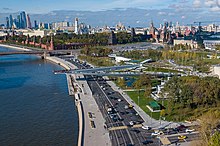 View of the Floating bridge in Zaryadye Park, with the Red Square and the Moscow Kremlin in the distance
View of the Floating bridge in Zaryadye Park, with the Red Square and the Moscow Kremlin in the distance Tverskaya Street, the main radial street in the city
Tverskaya Street, the main radial street in the cityWhen the USSR was dissolved in the same year, Moscow remained the capital of the Russian SFSR (on December 25, 1991, the Russian SFSR was renamed the Russian Federation). Since then, a market economy has emerged in Moscow, producing an explosion of Western-style retailing, services, architecture, and lifestyles.
The city has continued to grow during the 1990s to 2000s, its population rising from below nine to above ten million. Mason and Nigmatullina argue that Soviet-era urban-growth controls (before 1991) produced controlled and sustainable metropolitan development, typified by the greenbelt built in 1935. Since then, however, there has been a dramatic growth of low-density suburban sprawl, created by heavy demand for single-family dwellings as opposed to crowded apartments. In 1995–1997 the MKAD ring road was widened from the initial four to ten lanes.
In December 2002 Bulvar Dmitriya Donskogo became the first Moscow Metro station that opened beyond the limits of MKAD. The Third Ring Road, intermediate between the early 19th-century Garden Ring and the Soviet-era outer ring road, was completed in 2004. The greenbelt is becoming more and more fragmented, and satellite cities are appearing at the fringe. Summer dachas are being converted into year-round residences, and with the proliferation of automobiles there is heavy traffic congestion.[23] Multiple old churches and other examples of architectural heritage that had been demolished during the Stalin era have been restored, such as the Cathedral of Christ the Saviour. In 2010s Moscow's Administration has launched some long duration projects like the Moja Ulitsa (in English: My Street) urban redevelopment program[24] or the Residency renovation one.[25]
By its territorial expansion on July 1, 2012, southwest into the Moscow Oblast the area of the capital more than doubled, going from 1,091 to 2,511 square kilometers (421 to 970 sq mi), resulting in Moscow becoming the largest city on the European continent by area; it also gained an additional population of 233,000 people.[26][27] The annexed territory was officially named Новая Москва (New Moscow).













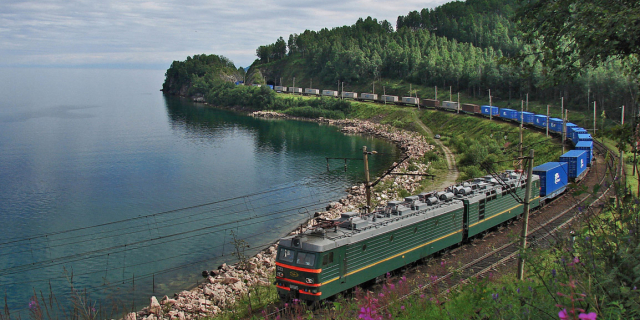






















Add new comment